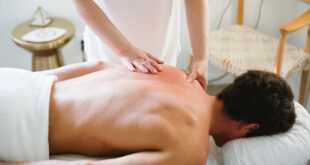Gum recession occurs when the supporting gums around the teeth retract, exposing more of the teeth and their roots. Different types of gum recession have different causes, but the gum recession is almost always secondary to another problem. In other words, you are unlikely to suffer gum recession on its own.
The purpose of this guide is to explore the most common causes of gum recession in otherwise healthy young individuals with no “gum disease” or periodontitis.
During the early phases of gum recession, you won’t notice much other than sensitivity to cold food, drinks, or dentists’ instruments. However, gum recession is almost always accompanied by non-carious cervical lesions.
What are non-carious cervical lesions?

Non-carious cervical lesions (NCCL) are indentures at the neck of the teeth due to the loss of tooth substance and the recession of the gums. These indentures are considered to be neither cavities nor caries, hence their name (Fig.1). Nonetheless, if you do not prevent them from progressing, they can deepen, ultimately leading to tooth loss. In advanced stages of NCCL, gum recession will be severe and there may be loss of the supporting bone below the gum. (Fig. 2)

Some clinicians have tried to differentiate types of NCCL based on the etiology and appearance of these lesions. But in a clinical situation, it’s almost impossible to be sure of one specific causing factor based on minuscule differences in appearance especially in the early phases of this condition. Gum recession is usually due to several factors (or bad habits) and does not have a single cause.
Causes of gum recession
Some dentists will tell you that your gum recession happened because you brushed your teeth too harshly. Others will blame your genes. These could be pieces of the puzzle but in most cases, they are not the most important factors.
According to a periodontist, Dr. Maziar Shabestari, Ph.D. at Vinterbro Tannlegesenter, most healthy patients with receding gums engage in one or more of the following bad habits:
- Frequent tooth clenching or grinding either while awake or asleep
- Wrong or inadequate brushing technique or routine
- Frequent consumption of eroding foods and beverages such as carbonated drinks and citrus fruits
- Use of abrasive toothbrushes or toothpaste
As stated earlier, there is no single cause for gum recession. It’s usually caused by a combination of the above-mentioned habits. It’s almost certain that genetics has very little to do with this condition in most clinical cases. Gum recession may also be caused by the use of orthodontics or movement in the teeth. It could also be linked to long-term use of chewing tobacco or “snus”, which is a popular tobacco product in countries such as Norway and Sweden.
Tooth clenching and grinding (Bruxism)
Some dentists believe that frequent clenching and grinding of teeth may lead to a gradual chipping of tooth structure in the cervix or neck of the teeth over long periods of time, contributing to gum recession. This process is called “abfraction”. This notion is somewhat debatable and has not been completely confirmed. While the jury’s still out on whether or not clenching and grinding really can lead to gum recession, it certainly makes sense to try to combat such behaviour if you think it applies to you.

Overconsumption of acidic beverages
People with NCCL and receding gums often consume large quantities of acidic food and beverages. This may lead to NCCL, but it won’t lead to gum recession as well unless combined with other bad habits.
Most people know that coke is damaging, but you may be surprised to know that orange juice is one of the most harmful beverages there is for the teeth. Those who drink acidic beverages such as coke, orange juice, or sports drinks more than three times a week are likely to suffer tooth erosion. You will notice this loss of tooth substance first in the neck of the teeth where the enamel is thinnest. You may also see it on the backs of your teeth (Fig. 4). Once enamel, the hardest and most resilient layer of your teeth has eroded, tooth wear will progress more rapidly.
In many cases of receding gums, there is a component of erosion involved.

Inadequate or wrong brushing technique/routine
Saying that NCCL or gum recession is caused by brushing the teeth too harshly may be a small part of the truth. The fact is much more nuanced and complicated. There are far more important factors here than how forcefully you brush your teeth.
The most important factor is your brushing technique itself. This includes how or at which angle you hold your brush against your teeth and the kind of brushing you do. While most people brush with long scrubbing strokes, the correct way is to use a small, circular vibrating motion.
Many people think that the removal of food particles is the main goal of brushing and flossing, but really, that is secondary to the removal of plaque or biofilm. If you have ever forgotten to brush your teeth and later scraped a white goo off them with the tip of your fingernail, you know what plaque is. Oral bacteria produce plaque in order to be able to multiply and attach themselves to the teeth.
Plaque proliferates at the gum line, which means it’s important to reach this part of your mouth as you brush. (Fig. 5).

As time goes by, the acid produced by the bacteria in this plaque will gradually demineralize and thin out the enamel in the neck of the teeth. Adequately removing this plaque, therefore, has far more clinical importance than how forcefully you brush your teeth.
Other factors with clinical significance are:
-
How abrasive your toothbrush and toothpaste are
Toothbrushes with medium or hard bristles and overuse of whitening toothpaste can easily contribute to the development of NCCL and gum recession.
-
How often you brush your teeth
Brushing your teeth more than twice a day will increase the wear on the teeth and the gum.
-
Whether you brush your teeth after consuming acidic beverages
One of the most damaging habits is to brush the teeth just after drinking acidic beverages.
-
How long you brush your teeth
Brushing all your teeth shouldn’t take more than 3-4 minutes.
-
Brushing motion
Long scrubs are more likely to damage the teeth and gums than small circular movements.
-
How much force you apply to your teeth with the brush
Orthodontics and the unintended movement of the teeth
If your teeth, specifically those in front of your lower jaw, are pushed or tipped forward, the bone can slowly wear away. Once the underlying bones are gone, the overlying gum will begin to recede (Fig.6).

In the picture above, the lower front tooth has lost its attachment (both bone and gum) after being tipped forward by an orthodontic procedure.
Treatment Options
If you suffer from gum recession, there are several periodontal procedures that may help, but none of these procedures have been studied properly, and little is known about the long-term results. The best thing you can do for this condition is to detect it in its early phases, pinpoint the underlying causes and address those issues to prevent its progression.
 Imagup General Magazine 2024
Imagup General Magazine 2024



